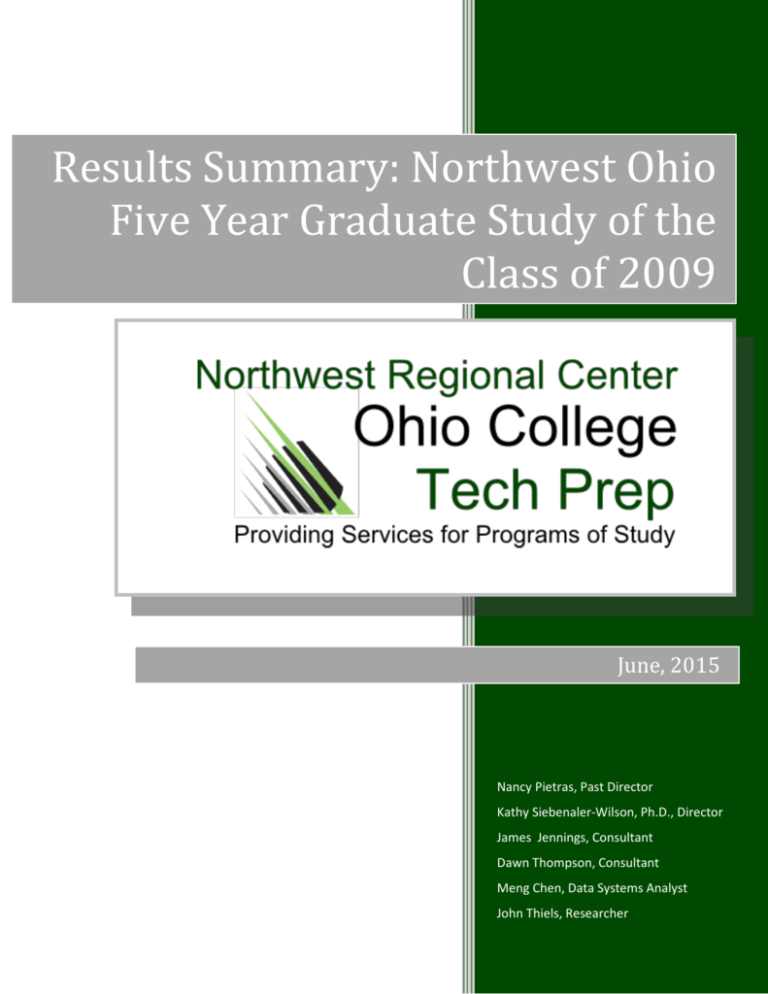Class of 2009 Study - Greater Northwest Ohio Tech Prep Consortium
advertisement

Results Summary: Northwest Ohio Five Year Graduate Study of the Class of 2009 June, 2015 Nancy Pietras, Past Director Kathy Siebenaler-Wilson, Ph.D., Director James Jennings, Consultant Dawn Thompson, Consultant Meng Chen, Data Systems Analyst John Thiels, Researcher Results Summary: Northwest Ohio Five Year Graduate Study of the Class of 2009 Northwest Ohio Five Year Graduate Study of the Class of 2009 1. Purpose of Study a. Tech Prep Defined i. “Combination of college preparatory academics and advanced career-technical education with the objective of a seamless, non-duplicative transition from high school to postsecondary education. All Ohio secondary career-technical education programs are Tech Prep.” (Ohio Career-Technical Education Dictionary, June, 2014) ii. In 2009, when this study began not all career-technical education programs were Tech Prep, there has been a 5-year transition period of converting all existing career-technical programs to the Tech Prep model. Appendix A contains a list of the Tech Prep programs existing in 2009 and the career-technical programs not yet transitioned to the Tech Prep model. Originally, the Tech Prep model was intended for high-tech Career-Technical programs; such as engineering and information technology programs and high-demand; such as health professions and teaching professions. The intent was to focus on these occupations with technical content at a post-secondary introductory level while incorporating college preparatory academics providing the high school student with the academic skills necessary to enter post-secondary education remediation free in math and language arts. Secondary career-technical instructors of Tech Prep Model programs met with related post-secondary instructors to discuss curriculum and make content and Page 1 Results Summary: Northwest Ohio Five Year Graduate Study of the Class of 2009 sequencing of curriculum decisions so the high school student would have the technical knowledge to “articulate” the credits of appropriate introductory courses in the related post-secondary course(s). This allowed agreements between the career-technical program and the related post-secondary program for students to waive or receive credit for introductory post-secondary courses. The general concept was: Why should a student who successfully completed a career-technical program be required to take related post-secondary introductory courses repeating the same content? The benefit to the student was earlier completion of their post-secondary program of study and a possible savings in tuition expenses. The post-secondary institution benefited by enrolling a student with introductory knowledge within the technical content program of study, and college-ready academic skills; in short a student who was more likely to be retained, and complete the post-secondary program. b. Research based assumptions i. High School Career-Technical instructors have long had antidotal evidence of former students who successfully continued their career pathway through postsecondary education and into the workforce. There has also been research based evidence of career-technical student success at the post-secondary level for the students who continue their studies with the same or related career pathway. See appendix B for a brief list of research studies demonstrating high school careertechnical completer’s success within post-secondary education programs. Page 2 Results Summary: Northwest Ohio Five Year Graduate Study of the Class of 2009 c. Research hypothesis i. Do Tech Prep students pursue post-secondary education at a higher rate than other direct from high school students in their graduation class? ii. Do Tech Prep students have a higher retention rate in post-secondary education than other direct from high school students in their graduation class? iii. And finally, Do Tech Prep students have a higher completion rate in postsecondary education than other direct from high school students in their graduation class: a. with an Associate’s Degree? b. with a Bachelor’s Degree? 2. Population of study a. Participant selection process i. Participating schools for this study voluntarily agreed to be involved in the proposed study in the spring of 2009. Schools invited were members of the Greater Northwest Ohio Tech Prep consortium, as it existed in the spring of 2009. The schools were members of the Northwest Ohio High Schools That Work region, as it existed in the spring of 2009. High schools indicated their willingness to participate in the study by providing a list of their high school graduates for the class of 2009. See Appendix C for a list of the high schools participating in the study. Appendix C also shows the number of graduates from each school, Tech Page 3 Results Summary: Northwest Ohio Five Year Graduate Study of the Class of 2009 Prep and non-Tech Prep, which was submitted to the National Student Clearinghouse, the ACT Code for the individual high schools –used as a school identifier, and the CTPD classification. b. High Schools That Work (HSTW) defined i. “A state-wide school improvement frame-work based on key practices and conditions for accelerating learning and raising academic standards for all students; initiative started under the auspices of the Southern Regional Education Board (SREB), based in Georgia; HSTW major goals related to raising academic and technical achievement, integrating academics and career-technical studies and influencing policy for school improvement and student achievement.” (Office of Career-Technical Education and the Association for Career and Technical Education, 2014) c. General description of the schools in the study i. There are essentially three types of high schools participating in this study; 1. Comprehensive High Schools. “One form of a Career-Technical Planning District (CTPD), or legal entity through which career-technical programs are delivered. It has 1,500 or more students and offers career-technical education in career centers and/or at existing high schools in the district.” (Office of Career-Technical Education and the Association for Career and Technical Education, 2014) a. For the purpose of this study, the following high schools are labeled Comprehensive: Clay High School, Bowsher High School, Libbey High School, Rogers High School, Scott High School, Start High School, Toledo Technology Page 4 Results Summary: Northwest Ohio Five Year Graduate Study of the Class of 2009 Academy High School, Waite High School, Woodward High School and Whitmer High School. 2. Joint Vocational School District (JVSD). “One form of a CTPD, or legal entity through which career-technical programs are delivered. It is an area, which serves two or more adjacent school districts and is governed by a joint vocational school board consisting of representatives from the participating districts.” (Office of Career-Technical Education and the Association for Career and Technical Education, 2014) a. For the purpose of this study there where two (JVSD) involved along with several member/associate schools: Four County Career Center and the following associate high schools: Hicksville High School and Patrick Henry High School; Penta Career Center and the following associate high schools: Lake High School, Springfield High School and Swanton High School. 3. Compact/Contract District. “One form of a CTPD, or legal entity through which career-technical programs are delivered. It is an area in which a number of school districts enter into a contract of operation to provide career-technical education.” (Office of Career-Technical Education and the Association for Career and Technical Education, 2014) a. For the purpose of this study there are two Compact/Contract School Districts involved in the study: Millstream Compact and the following associate high schools: Arcadia High School, Findlay High School and Liberty Page 5 Results Summary: Northwest Ohio Five Year Graduate Study of the Class of 2009 Center High School; Sylvania City School District and the following associate high schools: Northview High School and Southview High School. Note: The schools listed above are identified by the type of Ohio Career-Technical Planning District designations based on a document recently released by the Ohio Department of Education, Office of Career-Technical Education in March, 2015. 3. Design of the project/data a. Definition of High School Graduate vs Tech Prep Graduate i. A High School Graduate is an individual completing the proscribed course of study of a local school district to meet the qualifications for graduation and the requirements of the State of Ohio. The number of credits and the specific courses an individual student would complete would vary to some degree from one local school district to another, as long as minimum State of Ohio graduation guidelines were met. ii. A Tech Prep Graduate is an individual completing all of the above, but has included a specific course of study based on content standards for the particular Career-Technical/Tech Prep program the student was enrolled. The Tech Prep student should also have participated in an academic curriculum be generally defined as “College Prep”. Page 6 Results Summary: Northwest Ohio Five Year Graduate Study of the Class of 2009 b. Participating Schools The participating high schools in the study provided the researchers with a list of their 2009 graduates, along with the individual student birthdate; these were the identifiers required by the National Student Clearinghouse to conduct the “tracking” of the students. Each student was also identified with the six-digit ACT Code which is assigned to all secondary institutions in the country. Students within the high school graduating class who were completing the course of study for a Tech Prep Program were also assigned “TP” to the ACT Code for their school. By assigning an ACT Code and TP designation to the individual students we were able to identify the student’s high school and if they were a Tech Prep student when the data was returned by the National Student Clearinghouse. In the end we had 22 high schools/JVSDs participate in the study representing 4890 high school graduates. See Appendix C for a list of schools and the number of students were the cohort for this study. c. Use of the National Student Clearinghouse i. The National Student Clearinghouse “serves as a trusted agent to participating institutions providing support . . . for analytical needs.” The Clearinghouse offers many services, but we utilized what is referred to as their “tracking” service. By providing the basic information described above to the Clearinghouse, we were able to collect information on the post-secondary attendance patterns of the students in our study. Page 7 Results Summary: Northwest Ohio Five Year Graduate Study of the Class of 2009 ii. The student data file was assembled using the information outlined above and submitted to the Clearinghouse once each year over a five year period. Each year the Clearinghouse returned data to the researcher showing if each student attended a post-secondary institution. The data also included a variety of other information regarding the name of the institution, and what terms or sessions the student attended. Appendix D has a document outlining the types of information returned to the researcher. d. Three Questions of the Study: Essentially our study wanted to determine if there was a difference between, the non-Tech Prep high school student graduate and the Tech Prep student graduate, by answering three questions: i. Do Tech Prep students pursue post-secondary education at a higher rate than other direct from high school students in their graduation class? ii. Do Tech Prep students have a higher retention rate in post-secondary education than other direct from high school students in their graduation class? iii. And finally, Do Tech Prep students have a higher completion rate in postsecondary education than other direct from high school students in their graduation class: 1. with an Associate’s Degree, within three years of high school graduation? 2. with a Bachelor’s Degree, within five years of high school graduation? Page 8 Results Summary: Northwest Ohio Five Year Graduate Study of the Class of 2009 4. Findings/Presentation of Results The Class of 2009 Study used the graduation lists of 22 participating high school graduation classes, with students who completed a Tech Prep program within the graduation class, being identified with a TP to the high school’s ACT Code number. This list was submitted to the National Student Clearinghouse which returned tracking data for the students. The students who graduated from high school in 2009 were counted and broken down by each high school as the cohort. a. Research Question One: Do Tech Prep students pursue post-secondary education at a higher rate than other direct from high school students in their graduation class? Initial Post-Secondary Attendance Rates 76.6% 52.9% NON_TP TP We found 76.6% of Tech Prep graduates (TP) in our sample enrolled in a postsecondary educational program based on NSC tracking immediately after high school graduation. Only 52.9% of the remaining high school graduates (Non-TP) in our sample enrolled in a post-secondary educational program based on NSC Page 9 Results Summary: Northwest Ohio Five Year Graduate Study of the Class of 2009 tracking immediately after high school graduation. Based on this data it can be determined Tech Prep High School graduates had a higher rate of initial college enrollment than the other students graduating from the same graduation class. Appendix E has a table showing the initial college enrollment rates for each of the individual high schools participating in the study. b. Research Question Two: Do Tech Prep students have a higher retention rate in post-secondary education than other direct from high school students in their graduation class? Based on the cohort, the students who were enrolled in a post-secondary school in the next Fall term (2010) were counted as the second years’ students number. The 1st and 2nd retention rate is the percentage of 2009 cohort who continues at the school the next Fall. Using the same methodology, we can determine 1 st to 3rd, 4th and 5th year retention rates. Those results for the entire cohort are presented below: i. Table below shows the year to year retention rate of the Total cohort population, the Tech Prep Students only and the Non Tech Prep students. 50.00% 40.00% 30.00% Total 20.00% TechPrep 10.00% NonTechPrep 0.00% 1ST TO 2ND 1ST TO 3ND 1ST TO 4TH 1ST TO 5TH RETENTION RETENTION RETENTION RETENTION RATE RATE RATE RATE Page 10 Results Summary: Northwest Ohio Five Year Graduate Study of the Class of 2009 The data shows the percentages decrease from one year to the next through year 5 of the study. The Tech Prep cohort consistently remains higher throughout. As a result of this data it can be concluded Tech Prep students have a greater retention rate of attending post-secondary institutions than the entire graduation classes and of the non Tech Prep members of the graduation class. Appendix F has a table showing the persistency rates for each of the individual high schools participating in the study. c. Research Question Three: Do Tech Prep students have a higher completion rate in post-secondary education than other direct from high school students in their graduation class? 1. with an Associate’s Degree, within three years of high school graduation? a. By Year 3, 28 Tech Prep high school graduates had received an Associate’s Degree; 49 non-Tech Prep high school graduates had received an Associate’s Degree. Number of Students Earning an Associate Degree 3-Years after High School Graduation 49 28 Non-Tech Prep Tech Prep Page 11 Results Summary: Northwest Ohio Five Year Graduate Study of the Class of 2009 The data shows that more non-Tech Prep students earned an associate degree than the Tech Prep students. But when looking at the chart below the Associate Degrees earned based on the percentage of students that were high school graduates and the percentage of students that initially attended Post-Secondary, the differences between Non-Tech Prep and Tech Prep graduate is smaller. And in the case of all high school graduates, Tech Prep students earned Associate Degrees at a high rate. Percentage of students that earned an Associate Degree Non-Tech Prep Tech Prep 2.9% 2.3% 1.5% 1.8% Percentage based on High School Graduates Percentage based on number of Students that Entered PS 2. with a Bachelor’s Degree, within five years of high school graduation? a. By Year 5, 279 Tech Prep high school graduates had received a Bachelor Degree; 509 non-Tech Prep high school graduates had received a Bachelor Degree. Page 12 Results Summary: Northwest Ohio Five Year Graduate Study of the Class of 2009 Number of Students Earning a Bachelor Degree 5-Years after High School Graduation Non-Tech Prep Tech Prep 509 279 Non-Tech Prep Tech Prep The data shows that more non-Tech Prep students earned a Bachelor Degree than the Tech Prep students. But when looking at the chart below the Bachelor Degrees earned based on the percentage of students that were high school graduates and the percentage of students that initially attended Post-Secondary, the difference between Non-Tech Prep and Tech Prep graduates is smaller. And in the case of all high school graduates, Tech Prep students earned Associate Degrees at a high rate. Percentage of Students that Earned a Bachelor Degree Non-Tech Prep Tech Prep 30.3% 16.0% 18.0% 23.4% Percentage based on High School Percentage based on number of Graduates Students that Entered PS Page 13 Results Summary: Northwest Ohio Five Year Graduate Study of the Class of 2009 Appendix A Program_Name Tech Prep Programs in 2009 Accounting Administrative and Professional Support Agribusiness and Production Systems Agricultural and Industrial Power Aircraft Maintenance Animal Science and Management Auto Collision Repair Auto Specialization Auto Technology Biomedical Science Brick, Block and Cement Masonry Business Management Career Paths for the Law Professional Carpentry Construction--Management Cosmetology Criminal Justice Criminal Science Technologies Culinary and Food Service Operations Custodial Services Dental Assistant Early Childhood Education Electrical Trade Electronics Emergency Medical Technician-Secondary Energy Science Engineering Science Engineering Technology Environmental Control Technologies Exercise Science/Sports and Recreation Healthcare Financial Services Horticulture Information Support and Services Non Tech Prep Programs in 2009 x x x* x x x* x x x x x x* x x* x* x x x x x x x x* x* x* x x x x* x x x* x Page 14 Results Summary: Northwest Ohio Five Year Graduate Study of the Class of 2009 Interactive Media Manufacturing Design and Development Marketing Management Medical Management and Support Natural Resource Management Network Systems Programming/Software Development Public Safety Core Supply Chain Management Teaching Professions Therapeutic Pathway Visual Design and Imaging Welding and Cutting x x x* x x x x x x x x x x * Individual high school programs participated in the Tech Prep Model, but not all Pathway programs within the consortium. Page 15 Results Summary: Northwest Ohio Five Year Graduate Study of the Class of 2009 Appendix B Below is a brief list of research studies that demonstrate high school career-technical completer’s success within post-secondary education programs. Bishop, J., & Mane, F. (2004). The Impacts of Career-Technical education on High School Labor Market Success. Economics of Education Review, 23(4), 381-402. Bragg, D., & Rudd, C. (2007). Career Pathways, Academic Performance, and Transition to College and Careers: The Impact of Two Select Career and Technical Education (CTE) Transition Programs on Student Outcomes. In Brief. Bragg, D. D., Loeb, J. W., Gong, Y., Deng, C.-P., Yoo, J.-s., & Hill, J. L. (2002, November). Transition from high school to college and work for tech prep participants in eight selected consortia. St. Paul, MN: National Research Center for Career and Technical Education, University of Minnesota. DeLuca, S., Plank, S., & Estacion, A. (2006, February). Does career and technical education affect college enrollment? St. Paul, MN: National Research Center for Career and Technical Education, University of Minnesota. Hirschy, A., Bremer, C., & Castellano, M. (2011). Career and Technical Education (CTE) Student Success in Community Colleges: A Conceptual Model. Community College Review, 39(3), 296-318. Page 16 Results Summary: Northwest Ohio Five Year Graduate Study of the Class of 2009 Appendix C Appendix C shows the number of graduates from each school submitted to the National Student Clearinghouse, the ACT Code for the high school –used as a school identifier, and the CTPD classification. High School ACT Code Arcadia High School 360195 Clay High School Findlay High School (Millstream CTC) Four CCC Hicksville High School 365010 362135 # of Non TP TP Type of CTPD District Students Students Students Submitted 50 49 1 Millstream, associate school 207 57 150 Comprehensive 242 187 55 Compact 360203 362565 473 78 333 76 140 2 Lake High School Liberty Center High School 363440 362960 131 121 120 119 11 2 Patrick Henry High School 362495 78 76 2 Penta CC Springfield High School Swanton High School Sylvania Northview High School Sylvania Southview High School TPS-Bowsher High School TPS-Libbey High School TPS-Rogers High School TPS-Scott High School TPS-Start High School TPS-Toledo Technology Academy TPS-Waite High School TPS-Woodward High School Whitmer Senior High School 364089 362600 364923 364930 550 254 151 337 236 236 104 156 314 18 47 181 364931 319 229 90 365018 365015 365052 365025 365051 365064 282 110 228 180 315 32 202 71 174 126 296 1 80 39 54 54 19 31 JVSD Four CCC, associate school Penta, associate school Millstream, associate school Four CCC, associate school JVSD Penta, associate school Penta, associate school Compact, Sylvania Schools Compact, Sylvania Schools Comprehensive Comprehensive Comprehensive Comprehensive Comprehensive Comprehensive 365035 365070 365065 165 139 26 Comprehensive 104 86 18 Comprehensive 483 259 224 Comprehensive Total Number of Students Submitted to NSC 4890* 3332* 1558* * Note: The Total Number of Students Submitted to NSC is slightly higher than the number of student used in the final data analysis due to the elimination of duplicated students in the original data. Page 17 Results Summary: Northwest Ohio Five Year Graduate Study of the Class of 2009 Appendix D Page 18 Results Summary: Northwest Ohio Five Year Graduate Study of the Class of 2009 Appendix D (continued) Page 19 Results Summary: Northwest Ohio Five Year Graduate Study of the Class of 2009 Appendix D (continued) Page 20 Results Summary: Northwest Ohio Five Year Graduate Study of the Class of 2009 Appendix E Appendix E shows the initial post-secondary enrollment rate for each of the high schools participating in the study. SCHOOL Arcadia High School Four County Career Center Millstream Career Technical Center Patrick Henry High School Hicksville High School Springfield High School Liberty Center High School Lake High School Penta Career Center Swanton High School Sylvania Northview High School Sylvania Southview High School Clay High School TPS-Libbey High School TPS-Bowsher High School TPS-Scott High School TPS-Waite High School TPS-Start High School TPS-Rogers High School TPS-Toledo Technology Academy TPS-Woodward High School Whitmer High School Non Tech Tech Prep Prep Student Students 69.39% 100.00% 32.13% 58.57% 44.92% 83.64% 71.05% 100.00% 62.67% 50.00% 65.25% 44.44% 72.27% 50.00% 77.50% 54.55% 49.57% 59.87% 4.81% 65.96% 80.13% 81.67% 86.34% 81.11% 71.43% 68.00% 63.38% 87.18% 74.75% 67.50% 73.02% 69.96% 70.50% 65.38% 77.03% 63.16% 74.14% 66.67% 100.00% 87.01% 74.42% 44.44% 65.25% 74.89% Page 21 Results Summary: Northwest Ohio Five Year Graduate Study of the Class of 2009 Appendix F Appendix F shows a table of the persistency rates for each of the individual high schools participating in the study. High School Retention Rates Year to Year 1ST TO 2ND 1ST TO 3ND 1ST TO 4TH 1ST TO 5TH Arcadia High School 42.86% 34.69% 28.57% 18.37% Arcadia Tech Prep 100.00% 0.00% 0.00% 0.00% Four County Career Center 8.11% 5.11% 3.60% 3.30% Four CCC Tech Prep 32.86% 22.14% 17.86% 10.71% Millstream Career Technical Center 18.72% 10.70% 6.95% 4.81% Millstream Tech Prep 49.09% 34.55% 32.73% 23.64% Patrick Henry High School 22.37% 21.05% 19.74% 14.47% Patrick Henry Tech Prep 50.00% 100.00% 50.00% 0.00% Hicksville High School 38.67% 29.33% 24.00% 14.67% Hicksville Tech Prep 0.00% 0.00% 0.00% 0.00% Springfield High School 43.22% 33.90% 30.93% 22.88% Springfield Tech Prep 22.22% 16.67% 11.11% 5.56% Liberty Center High School 51.26% 40.34% 36.97% 20.17% Liberty Center Tech Prep 0.00% 0.00% 0.00% 0.00% Lake High School 49.17% 40.00% 37.50% 22.50% Lake Tech Prep 18.18% 9.09% 9.09% 18.18% Penta Career Center 15.95% 9.91% 6.90% 3.45% Penta Tech Prep 29.94% 22.29% 18.79% 13.69% Swanton High School 0.96% 0.96% 0.96% 0.96% Swanton Tech Prep 48.94% 42.55% 31.91% 29.79% Sylvania Northview High School 66.67% 60.26% 57.05% 38.46% Sylvania Northview Tech Prep 64.44% 63.33% 58.89% 31.11% Sylvania Southview High School 72.25% 70.04% 64.32% 35.68% Sylvania Southview Tech Prep 65.56% 58.89% 54.44% 31.11% Clay High School 30.36% 30.36% 25.00% 14.29% Clay Tech Prep 48.00% 38.00% 31.33% 21.33% TPS-Libbey High School 22.54% 12.68% 14.08% 12.68% TPS-Libbey Tech Prep 38.46% 23.08% 23.08% 12.82% TPS-Bowsher High School 44.55% 38.12% 34.16% 21.78% TPS-Bowsher Tech Prep 32.50% 31.25% 23.75% 20.00% TPS-Scott High School 20.63% 15.87% 7.94% 5.56% TPS-Scott Tech Prep 27.78% 22.22% 20.37% 12.96% TPS-Waite High School 41.01% 30.22% 23.02% 11.51% TPS-Waite Tech Prep 7.69% 11.54% 7.69% 11.54% TPS-Start High School 39.86% 30.74% 25.00% 21.62% TPS-Start Tech Prep 21.05% 15.79% 15.79% 15.79% TPS-Rogers High School 37.36% 28.74% 22.41% 14.37% TPS-Rogers Tech Prep 29.63% 20.37% 18.52% 7.41% TPS-Toledo Technology Academy 0.00% 0.00% 0.00% 0.00% TPS-TTA - Tech Prep 51.61% 48.39% 38.71% 38.71% TPS-Woodward High School 30.23% 27.91% 18.60% 13.95% TPS-Woodward Tech Prep 11.11% 16.67% 5.56% 0.00% Whitmer High School 38.22% 31.66% 27.41% 19.31% Whitmer Tech Prep 56.95% 45.74% 40.36% 25.11% Page 22








